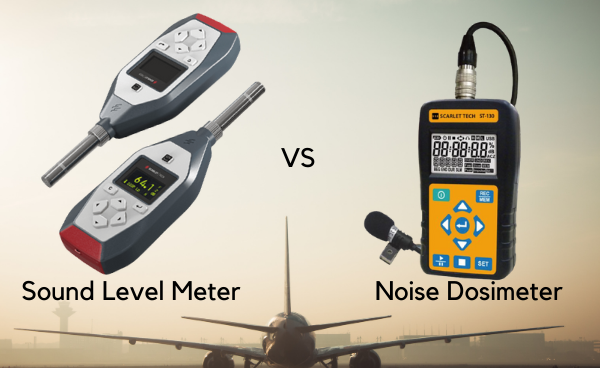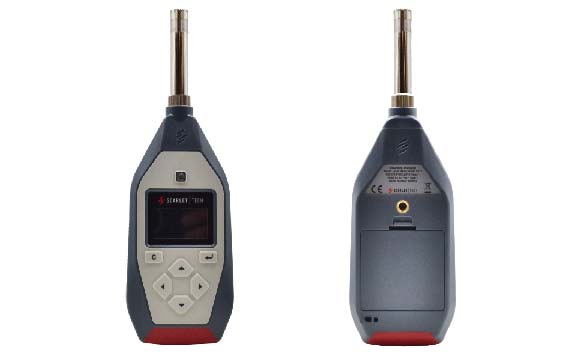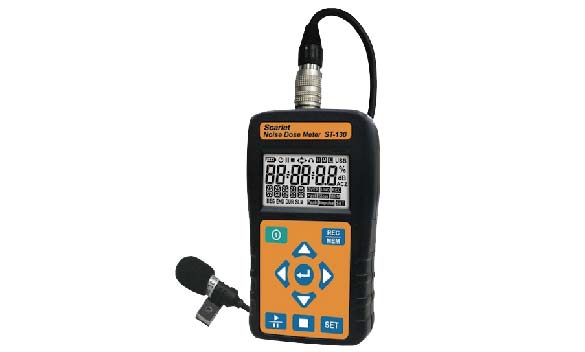Know How –
When to use which? Sound Level Meter Vs Noise Dosimeter
Most people in common often thinks that sound level meter and noise dosimeter are the same while in fact it is not. To understand when you should use a sound level meter (SLM) or a noise dosimeter, we must know what each devices measure. But, let’s first understand noise levels and what how noise levels relate to which measuring device should be used.
Noise Levels
The 2015 Noise Regulations set noise exposure level and limit values that require employers you to take specific action at certain action values. The purpose is to prevent or reduce risks to health and safety from exposure to noise at work.
What are the action levels and limit values?
Action Levels:
- Average daily or weekly noise levels exposure of your employees. This is the LEP,d (daily exposure) or LEP,w (weekly).
- The maximum noise (peak sound pressure) employees are exposed in a working day.
Lower exposure action values:
- daily or weekly exposure : 80 dB
- peak sound pressure : 135 dB
Upper exposure action values:
- daily or weekly exposure : 85 dB
- peak sound pressure :137 dB
Limit Values– the levels of noise exposure which must not be exceeded :
- Daily or weekly exposure ((LEP,d): 87 dB
- Peak sound pressure (LCPeak) :140 dB
Noise Dosimeters
Noise dosimeters are use to measure the direct noise exposure of an employee. They are small, light-weight, cable-free device worn on shoulder close to worker’s ear to measure noise. Noise dosimeters are ideal for industries where shifts are involved, such as construction (building sites), entertainment (orchestras, music performance) and the emergency services (police). Rather than having a health and safety officer stay with workers throughout the assessment, each employee can be left to his or her own devices while the noise dosimeter takes accurate and detailed measurements throughout the day.
Noise dosimeters work by storing sound level measurements to provide an average noise exposure reading for a specified period, such as an 8-hour workday. The second-by-second measurements provided by noise dosimeters are ideal for performing detailed analyses of daily patterns in an exposure. In short, a noise dosimeter is perfect for personal noise measurements.
Sound Level Meters (SLM)
While noise dosimeter is perfect for personal use, there are some measurements in which SLM is needed. For instance, when you need to know the overall noise level of a machinery or certain area then you will need a sound level meter. SLM measures equivalent sound levels at a particular location. There are two types of sound level meters; Class 1 and Class 2. Class 1 sound level meter is the ‘precision’ grade meter, while Class 2 sound level meter is the ‘general grade’ meter.
Depending on needs and use, either Class 1 or Class 2 types both were accepted under the noise regulations. For heavy-duty industries such as construction, traffic assessment, laboratory assessment in which a wider sound frequency range and narrower tolerances are needed for higher accuracy, Scarlet Class 1 Sound Level Meter ST11D is an ideal option.
If you are still not sure about what is class 1 sound level meter is, you can also read more here.
In short,
- Sound Level Meters: when you need to know the noise level of a particular area/location or process.
- Noise Dosimeters: when you need to find out a specific person/employee’s direct noise exposure.
Ask Anything
Scarlet is ready to help and offers a great solution for you, feel free to send your inquiries to info@scarlet.com.tw and let our professional team and experts assist you. Get a fast response in few hours here.

Scarlet Class 1 Sound Level Meters
ST-11D

ST-11D Features
• Class 1 Complies with IEC-61672-2013
• 10 Hz-20k Hz frequency range
• 27 dB-140 dB measurement range
• Data logging & record function
• Measures and displays Leq value
• Long term measurement
ST-130

ST-130 Features
• Perform OSHA and IEC noise accumulation surveys
• 6 built-in standard dose measurement setups: OSHA/ MSHA/DOD/ACGIH/ISO85/ISO90
• Data logger up to 10,00,000 readings
• Adjustable criterion level, exchange rate & threshold
• Sampling times between 1 sec to 2 hr
• Stores up to 10,000 dose meter survey results
• Dose Meter Mode: record time stamp, %Dose, TWA8, LEP, 8h, Leq, SEL, LN%, SPLmax, SPLmin, PeakMAX
• Sound Level Meter mode: Leq, PeakMAX & SEL
• USB interface. Support Windows XP / Vista / 7 / 8
Pick a perfect Anemometer
How to Choose the Perfect Anemometer for Construction Site Safety?
There are many different types of anemometers in the market with different functionalities. Before choosing any of the anemometers, you have to get complete knowledge about it in order to meet your demands.
Choosing anemometers is particularly important in situations where loads and equipment will be raised significantly above the ground or building, which is especially relevant when planning tasks involving crane operation and heavy lifting. Attaching an anemometer to the boom point is a sensible way to monitor the different wind speeds at operating altitudes for cranes.
Intrinsic Safety
Official Safety Standard for Explosion-Proof
Outside of North America, ATEX (Appareils destinés à être utilisés en ATmosphères EXplosives) and IEC (International Electrotechnical Commission) provide standards that are recognized internationally.
These organizations, unlike FM, UL and CSA, do not perform their own testing but rather have notified bodies to perform the testing to meet the standards they set. To make their products applicable to international businesses, many North American companies will certify their products to ATEX and/or IEC standards in order to make them applicable to international businesses.
Other Know Hows
Pick a perfect Anemometer
How to Choose the Perfect Anemometer for Construction Site Safety?
Choosing anemometers is particularly important in situations where loads and equipment will be raised significantly above the ground or building.
Intrinsic Safety
Official Safety Standard for Explosion-Proof
Outside of North America, ATEX (Appareils destinés à être utilisés en ATmosphères EXplosives) and IEC (International Electrotechnical Commission) provide standards that are recognized internationally.
